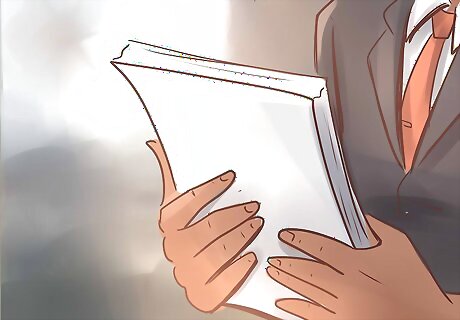
views
Responding to the Lawsuit

Receive your copy of the complaint. The official will start a lawsuit by filing a “complaint” with the court. A complaint is a legal document in which the official identifies the parties (you and the official). The complaint also explains the alleged violence that you committed against the official. You will receive a copy of the complaint along with a summons. The summons will explain how much time you have to respond to the lawsuit. Write down the date and commit to responding on time. If you fail to respond, then the official could get a “default judgment” against you. With a default judgment, the official basically wins without having to go through a trial. The official can then move to garnish your wages or put a lien on your property. Because default judgments are hard to set aside, you should make sure that you respond to the lawsuit in a timely manner.

Schedule a consultation with a lawyer. After reading the complaint, you should gather referrals for a personal injury attorney who can defend you. You should talk to teammates or players on other teams and ask if they have ever been sued for personal injuries. If so, ask if they would recommend their attorneys. You can also get referrals from your local or state bar association. Type your city or state and “attorney referral” into your favorite web browser. As soon as you get the name of a lawyer, call and schedule a half hour consultation. Most attorneys offer consultations for free or for a reduced fee.

Discuss possible defenses. At the consultation, you can discuss possible defenses to the official’s lawsuit. It will be difficult to defend yourself if you physically attacked the official and there is video or photographic evidence of the attack. However, you may have certain defenses depending on the circumstances: The official isn’t as injured as he or she claims. In the complaint, the official should explain in some detail the injuries you allegedly caused. However, the official may be exaggerating, or the official might have compounded his injury by not following his doctor’s orders. You didn’t attack the official. You can argue that someone else used violence against the official. You could also argue that any contact was purely accidental because you were pushed in the back or you fell. The official waited too long to sue. Each state sets deadlines for people to bring lawsuits. This is called the “statute of limitations.” In a personal injury lawsuit, the deadline differs by state, but it is often two or three years from the date of the assault. If the official waited too long to file the lawsuit, you can ask the judge to dismiss the lawsuit.

Gather helpful evidence. You will need evidence to support your defense. For example, someone might have made a video of the game from the stands showing that your contact with the official was accidental. Try to get a copy of the video. You can also write down your memories as soon as possible after the incident. Write down what you were doing, or trying to do, when the official was injured. For example, you might have been tackling a player when you lost your grip and slammed into the official.

Draft your answer. You need to answer the complaint by drafting and filing an answer. If you hired a lawyer, then he or she can draft the answer for you. In the answer, you must admit, deny, or claim insufficient knowledge to admit or deny each claim. If you are representing yourself without a lawyer, then you should get a printed “fill in the blank” answer form from your court clerk. Many courts now have these forms. If no form is available from your court, then you can use the form available from the United States federal courts at http://www.uscourts.gov/forms/pro-se-forms/defendants-answer-complaint. Revise it to suit your circumstances (e.g., change the court name).

File the answer. After you have completed the answer, you should make several copies. Take the original answer and your copies to the court clerk and ask to file. The clerk will stamp all of your copies with the date. You might have to pay a filing fee. Ask the court clerk for the amount and acceptable methods of payment. Keep one of the copies for your records.

Serve a copy of the answer on the official. You must send the official a copy of your answer. If the official has a lawyer, then serve the lawyer instead. Each court has different rules for making service on a party. You should ask the court clerk what methods of service are acceptable. Generally, you should be able to serve a copy of the answer on the official in the following ways: Hire a process server. You can look in your phone book for process servers or find them on the Internet. Process servers make personal hand delivery on the other party for a small fee. Generally, process servers charge $45-75 per service. Pay the sheriff to make service. In some courts, the sheriff can make service for a small fee. The amount should be equal to what a private process server would charge. Have someone 18 or older make hand delivery. You can’t make delivery, but someone who is not a party to the lawsuit usually can. You could ask a friend or colleague to make service for you. Mail a copy to the official. In some courts, you can deliver a copy of the complaint using certified mail, return receipt requested.

File the proof of service form. Whoever serves a copy on the official should fill out a form. The form goes by different names, such as “Affidavit of Service” or “Proof of Service.” You can get the form from the court clerk. After the server fills out the form, you must file it with the court to show that you made service on the official. Keep a copy of the form for your own records.

Take part in discovery. Litigation really gets going when discovery commences. In discovery, both parties will collect and exchange information relevant to the case. You will be able to collect facts, talk with witnesses, find out what the other side is going to say, and assess the strength of your case. You can use the following tools to help you: Informal discovery, which will include interviewing witnesses, gathering publicly available documents, and taking photographs. Interrogatories, which are written questions to a party or witness. These questions are answered under oath and can be used in court. Depositions, which are in-person interviews with parties or witnesses. These interviews are conducted under oath and can be used in court. Requests for documents, which are formal requests to access documents that are not publicly available. These documents might include emails, text messages, and internal memos. Subpoenas, which are court order requiring someone to do something.

File a motion for summary judgment. Before attempting a settlement or going to trial, you should try to get the case (or some causes of action) dismissed by filing a motion for summary judgment. A motion for summary judgment asks the court to end the litigation before it ever gets to trial. To succeed, you will need to show the judge that there are no genuine issues of material fact and that you are entitled to judgment as a matter of law. To do so, you will submit evidence and affidavits along with your motion. When the judge analyzes your motion, he or she will make every assumption in the other party's favor. If you succeed, the judge will rule in your favor and the case will end. In some instances, a judge will agree with you on about some of your motion but not all of it. If this happens, a judge may rule in your favor on certain issues while leaving other issues to be decided during trial.
Negotiating a Settlement with the Official

Contact your insurer. You might have insurance. For example, a homeowner’s policy could cover you. Homeowner’s insurance typically covers personal injuries caused by you or your family, even when the damage is caused off your property. Although homeowner’s insurance does not cover intentional acts, it might cover you if you injured the official accidentally. Find your homeowner’s policy and locate the number to call to file a claim. You shouldn’t delay. Gather relevant information, such as the name of the official, a copy of the police report, and any other evidence that you have. If the insurer agrees to represent you, then a claims adjuster will participate in any settlement negotiations. The insurance policy might also cover the cost of a defense attorney.

Read the official’s demand letter. The official might have suggested negotiations by sending you a demand letter. In this letter, the official described his or her injuries and demanded that you pay a certain amount of money. You should treat this demand letter as the opening move in negotiation discussions. The amount the official demanded is probably higher than what he or she will settle for. For example, if the official demanded $100,000, then he may settle for half of that ($50,000). If your insurer is representing you, then send the demand letter to your insurer. You should also send a copy to your lawyer, if you have one.

Come up with a negotiation strategy. You cannot go into negotiations blindly, hoping everything will turn out okay. You need to strategize. Accordingly, you should think about the following information, which will be critical to successful negotiations: Your ideal resolution. You probably would like to get off without having to pay any money to the official. However, this is unlikely. Instead, talk with your lawyer about a realistic resolution. For example, paying only 33% of what the official has demanded might be a great resolution for you. The absolute most you will pay. This is your “walkaway” point. If the official won’t accept this amount, then you leave negotiations. The strength of the official’s case. If the official has videotaped evidence of you sucker punching him, then he has a strong case and can probably win a lawsuit against you. For this reason, the official has incentive to hold out for as much money as he can get. However, if the official has a weak case, you can be more aggressive in negotiations. Look objectively at the evidence.

Meet to negotiate. Negotiations may happen in person, face-to-face. Alternately, you could negotiate solely through letters. If your insurer is defending you, then your claims adjuster will take the lead on negotiations since the insurer will pay the settlement amount. If you don’t have an insurance adjuster, then you should negotiate with your attorney’s assistance. Be sure to attend any settlement discussions with your lawyer and offer your input. Don’t settle too quickly. This is a common mistake in negotiations. You should try to get the best deal that you can. The other side expects you to negotiate.

Draft a settlement agreement. Your lawyers can draft the agreement for you. A settlement agreement is a contract between you and the official, and either one of you can sue if the other violates the agreement. For example, you will probably agree to pay the official some money. If you refuse, then the official could sue you. If you represented yourself during negotiations, then at a minimum take a proposed settlement agreement to a lawyer and have the lawyer advise you about whether it is a good deal or not. Settlement agreements often need to include specific language, and only a lawyer can tell you if the agreement satisfies legal requirements. Also make sure that the official signs a “full release” along with the settlement agreement. This release is an agreement not to sue you in the future for any injury related to the incident. In fact, you should refuse to settle unless the official agrees to sign a full release.
Defending Yourself at Trial

Pick a jury. Jury selection is called “voir dire.” During this process, the judge will call a panel of prospective jurors to sit in the jury box. The judge will then ask jurors basic questions, such as their jobs and hobbies. The judge will also ask if any juror knows either you or the official and if the juror knows any facts about the dispute. If you a professional athlete, then some jurors probably will have heard about the incident. If you think a juror can’t be fair, then you can ask the judge to dismiss the juror “for cause.” For example, a juror might admit that she has made up her mind because she was at the game and saw the incident. In this situation, the juror cannot be fair and should be excused from jury service. You will also have a number of “peremptory challenges.” You can use a peremptory challenge to dismiss a prospective juror from the panel without having to give a reason or to ask the judge’s permission. The only limitation on peremptory challenges is that you can’t use them to discriminate on the basis of race, ethnicity, or sex.

Cross-examine the official’s witnesses. The official will present evidence first. Most evidence will take the form of witnesses and documents. Your lawyer will have a chance to cross-examine all of the official’s witnesses. If you are representing yourself at trial, then see Question Witnesses when Representing Yourself for tips on how to conduct cross-examination.

Present your own evidence. As the defendant, you get to go second. You might want to ask questions of several witnesses who saw the incident but who can testify that you didn’t deliberately harm the official. Remember that witnesses can only testify to things they personally observed. You cannot have someone testify to second-hand information or gossip.

Testify on your behalf. As the defendant in the lawsuit, you will probably have to testify in order to explain your actions. To prepare, you can do a practice run with your lawyer. To be an effective witness, you should follow these tips: Always tell the truth. You don’t gain anything by lying or trimming the facts. Don’t guess. If you don’t know the answer to a question, then say you don’t know the answer. Always understand the question before answering. In order to be as truthful as possible, you need to understand exactly what the lawyer is asking. If you are unsure, ask the lawyer to clarify or rephrase the question. Dress professionally. Jurors are judging you based on your appearance. Try to wear a suit if you have one. For other tips, see Dress for a Court Hearing. Look at the lawyer asking you questions and then make eye contact with the jurors when you answer.

Wait for the verdict. At the close of evidence, the judge will read the jury its instructions. The jury then retires for deliberations. The jury might reach a verdict after an hour of deliberation, or it might take longer. If you leave the courtroom, then the court clerk will contact you by phone when the jury has arrived at a verdict. In many state courts, a jury does not need to be unanimous. This means that the official can win even if a couple of jurors agree with you. In many states, a plaintiff only needs nine or 10 jurors (out of 12) to agree with him in order to win. If you are in federal court, then the jury must still be unanimous.

Appeal the verdict, if you lose. Discuss with your lawyer whether bringing an appeal is worthwhile. Appeals can be time-consuming and expensive. You have to pay for trial transcripts to be created. You also will not be able to represent yourself on appeal since they are so technical. Schedule a consultation with a lawyer and get his or her advice about whether you should bring an appeal. If you do want to file an appeal, then you must move fast. Generally, courts give you only 30 days or less to file your Notice of Appeal. In some states, such as Missouri, you have only 10 days.




















Comments
0 comment